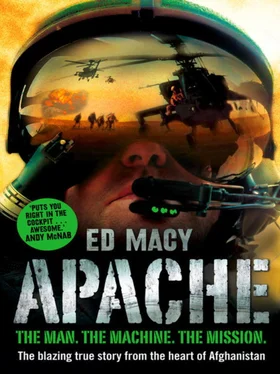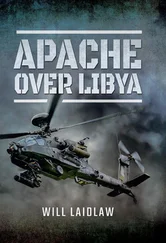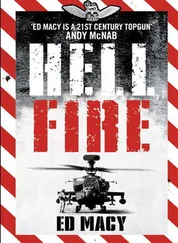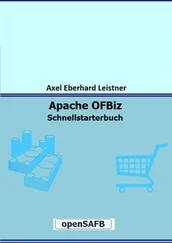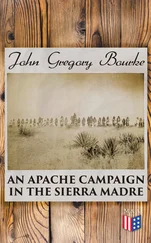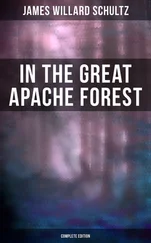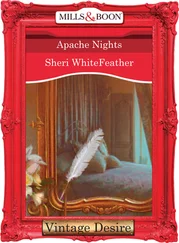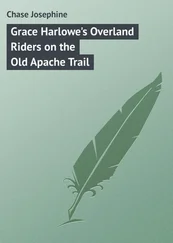1 ...8 9 10 12 13 14 ...84 The Boss put it to the floor. Up until then, the Apaches had been working under the callsign ‘Wildman’ – which wasn’t bad, but a bit of a mouthful if you were in a hurry. After hours of spirited debate over several days, someone came up with ‘Ugly’. It summed up the machine perfectly – how it looked and what it did. From then on, we’d be known as Ugly Five Zero, Ugly Five One, Ugly Five Two, and so on. We’d announce ourselves at contacts over the net with fresh pride.
‘Who are you?’
‘We’re Ugly.’
‘Funny guys; who are you?’
‘We really are Ugly. We’re the Apache boys.’
We weren’t the only troops to be changing over in Helmand. After one hell of a tour, the Paras and airborne gunners of 16 Air Assault Brigade were being replaced by Britain’s other elite infantry formation, the Royal Marines of 3 Commando Brigade.
The commandos did their best to keep things quiet for their first few weeks, to find their footing. That worked well for us too, allowing us to ease the squadron’s new pilots gently into the scene. As well as the Boss, there were four more new faces on this tour, and there was a vast amount for the three men – and one woman – to take on board.
Every pilot did an initial familiarisation flight. It was important to learn about – or reacquaint ourselves with – the key locations and the general lie of the land over which we were expected to fight. I flew with the Boss (as Ugly Five One), with Carl flying Billy on our wing (Ugly Five Zero). Apache crews nearly always flew in pairs so they could watch out for each other in the air and share the workload on the ground. Double the birds meant double the fire power for the boys beneath us, though we didn’t always get the option. We were due to lift at 1500, so we got changed straight after lunch.
Strict rules dictated every shred of clothing we wore while flying – right down to our underwear: a pair of special socks, long johns and a long-sleeved T-shirt, all fire retardant. One Apache pilot I knew even used to wear a Formula 1 driver’s facemask. Surrounded by 3,000 lb of aircraft fuel, every one of us knew that we were flying a potential fireball.
Over our underwear went a desert camouflage shirt and trousers. Our uniforms were designed to look just like normal army Disruptive Pattern Material (DPM), but were also fire retardant. The pockets were double-sealing, so nothing would fall out of them and foul the flying controls in flight.
Flying suits were a big no-no, whatever Billy thought. They were fine for training in the UK, but if we got shot down we wanted to look like regular infantry. Our uniforms carried no unit markings, and I didn’t even wear rank slides. The Taliban would have given their eye teeth to get their hands on a ‘mosquito’ pilot.
We wore fire-retardant shammy leather gloves – in white, green or black – thin enough to give you a good feel of the controls, and flying combat boots with a special sole that didn’t pick up debris on our walk to the aircraft. Anything loose in the cockpit could jam the controls and cause the helicopter to crash
Over our shirts, we wore a Life Support Jacket – a camouflage canvas survival waistcoat packed with the kit we might need to evade capture and keep us alive if we went down. The survival LSJ was tailor-made; it had to fit tightly enough to hold in our innards and help preserve circulating body fluid if we got shot. A few more minutes of consciousness might make the difference between getting to the ground safely and dropping out of the sky.
Clipped to the survival jacket was a triangular-shaped bulletproof Kevlar breastplate that would stop a 7.62-mm round at point-blank range. We tucked it up inside the jacket to cover our heart but called it the Ball Cruncher because if you grabbed your kit in a hurry and threw it over your shoulder as you ran, the plate would coming winging down between your legs.
My 9-mm Browning and a couple of ammunition clips – thirteen rounds in each – were strapped to my right thigh in a black holster with Velcro fastening. Every pilot kept his second personal weapon – an SA80 carbine – in a bracket inside the cockpit. It looked like the normal full length assault rifle but had a very short barrel and an additional grip at the front.
Strapped to my left leg was my Black Brain – a filofax-like notepad, knee board and pencil for any crucial information I needed to jot down for or during the sortie. That meant the day’s codewords, the JTAC callsigns we needed to hook up with on the ground, or grids we were heading for.
I also kept a crib sheet in it containing any detail I might have needed to know about the myriad other offensive coalition aircraft that were working around us. There was quite an array: the UK’s Harrier GR7s, the US’s F16s, A10 Thunderbolts, EA6B Prowlers, B1B Lancer bombers, B52 bombers, AC130 Spectre gunships and AH64 Apaches, the Netherlands’ F16s and AH64s, France’s Mirage 2000s, and Belgium and Norway’s F16s. We needed to recognise all the aircraft callsigns the moment they came on the net, their national Rules of Engagement restrictions, what weapons they carried, and the safety distances we needed to hold to avoid catching any of their impact.
‘Ramit Three Seven, launching a GBU38 in three zero seconds, Ugly Five One acknowledge?’ If the shout came in there was no time to play Twenty Questions; we had to know who Ramit was and what he meant by a 38. A few seconds to discover that a Dutch F16 was about to launch a 500-lb JDAM bomb was usually enough for us to skedaddle to the safe distance.
Each pilot also had their own grab bag, a canvas satchel wedged beside their seats. If we went down, we’d grab them and go. What went in them was entirely down to personal preference. Some of the guys put ammo and rations in theirs; others stuffed them with bottles of water too. Apart from my field dressing and spare morphine vial, mine was crammed full of ammunition. I’d asked our storeman for everything he could spare.
As an ex-infantryman, I knew all about ground fighting. The way I saw it, the more bullets I had, the longer I’d stay alive. I’ve never needed to drink very much and I could kip when I was safe. In my ammo-bag I put four additional magazines of 9-mm, four thirty-round magazines of 5.56-mm for the SA80 carbine, and an extra bandolier of 120 5.56-mm rounds – as much as I could carry.
I’d also slipped in two L2 fragmentation grenades I’d stashed from the first tour and two smoke grenades – one green smoke, one red. Grenades were strictly forbidden inside the aircraft in case they went off, but I knew my weapons and was happy to carry them.
We stowed our fighting gear and ‘go-bags’ in the boot of the Apache, just forward of the tail section. Go-bags contained luxury items for long-term evasion in case we went down in the mountains or had a malfunction and needed to land at a distant firebase: sleeping bags, wash kit, warm clothing, waterproofs, a bivvie, spare food, water and the like. I’d also decided to add a full set of army webbing, body armour and a proper combat helmet. It was a lot to run with, but I didn’t want to leave the one item that could save my life.
The flight line was at the most easterly point of Camp Bastion. There were two north–south runways; ours, a 200-metre length of metallic matting surrounded by rocks to suppress the dust, and a kilometre-long dirt strip for the C130 transporters.
Three hangars ran alongside the western edge of our runway: one for aircraft, a second for the technicians’ workshop, and a third for personnel, shared by pilots and Groundies. Our hangar contained a row of weapons crates, camping cots for the on-duty Groundie shift (they worked in twenty-four hour stints), a basketball hoop and a row of lockers. Each of us had our own, where we’d dump anything in our pockets before walking out to the aircraft.
Читать дальше
Конец ознакомительного отрывка
Купить книгу
